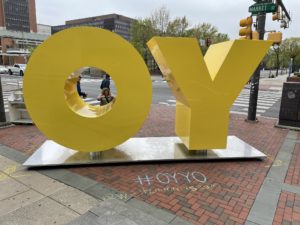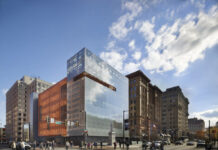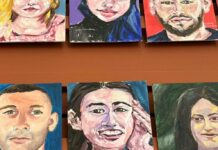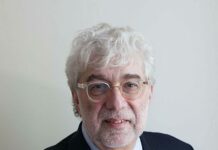
It’s easy to spot the Weitzman National Museum of American Jewish History these days. For the past six months, it’s been home to the eight-by-16-foot Lamborghini yellow “OY/YO” sculpture that sits outside its doors.
The sculpture has become a selfie destination and makeshift playground for young museumgoers, transcending its original purpose of exploring the multitudinous meanings of just two letters.
Deborah Kass, the artist behind “OY/YO,” is well aware of the sculpture’s changing meaning in its temporary Philadelphia home. On Oct. 27 at 8 p.m. at the Weitzman, she’ll discuss “OY/YO”’s evolution and the role of art in the growing landscape of antisemitism with Neubauer Family Executive Director and President of The Barnes Foundation Thom Collins.
“The sculpture truly speaks to the diversity that is Philadelphia,” said Weitzman Chief Curator & Director of Exhibitions and Interpretation Josh Perelman. “The word ‘oy’ and the word ‘yo’ mean so many different things in different cultural contexts. While it announces in a very wonderful way the presence of a Jewish institution on Independence Mall, its flexibility and mutability — and to different languages in different contexts — embraces the full spectrum of Black, brown, immigrant people from every place in the world who have made Philadelphia their home.”
First created as a painting in 2011, “OY/YO” was inspired by Ed Ruscha’s 1962 painting “OOF” and drew influence from Robert Indiana’s “LOVE,” which has become iconic in Philadelphia. Kass, known for her works that combine art history and pop culture with commentary on feminism, gender and sexuality, racism and identity, wanted to explore the numerous meanings behind the two words.
Based in Brooklyn, New York, the Jewish artist designed “OY/YO” to be an homage to the informal greeting and a nod to the word “I” or “me” in Spanish and the Yiddish phrase to express exasperation.
“The fact that two letters can mean so many different things to so many communities is really the joy of the piece,” Kass said. “And you can’t say ‘joy’ without ‘oy’.”
“OY/YO” was transformed from two to three dimensions in 2015 when the monumental sculpture was installed at Brooklyn Bridge Park. Since then, it’s lived in many cities. It will remain in Philadelphia until next May.
During its time in the City of Brotherly Love, the piece has taken on additional meanings, most famously in its tribute to Rocky’s “Yo, Adrian!” line from the eponymous Philly-based film.
But “OY/YO”’s placement outside of the Weitzman has established the statue as a “conduit” between Independence Mall’s breadth of American history and the Weitzman’s scope of American Jewish history, Collins said.
“It’s absolutely powerful that this piece be front and center in that interface between what could be construed as a central element of American history broadly and Jewish American history,” he said.
Kass finds the location of her piece outside of a Jewish institution even more powerful due to rising antisemitism in the U.S. She cites the 2018 Pittsburgh Tree of Life synagogue shooting and Republican gubernatorial candidate Doug Mastriano’s association with antisemitic politicians and appropriation of Jewish symbols as evidence of growing hatred against Jews.
“As the culture changes, the relevance of this just keeps not only changing, but being added to — it’s an additive process,” Kass said. “Doug Mastriano wasn’t running when I made that piece; antisemitism wasn’t in the news. So, over the course of years, it has unfortunately been increasing, been more and more in the news.”
Beyond being a physical portal between Independence Mall and the Weitzman and a symbolic portal into American Jewish history, the sculpture serves as a portal of access to those not well-versed in Kass’ works or in what “OY/YO” represents.
A growing selfie destination, “OY/YO” has become an opportunity to shine light on the Weitzman and begin a simple conversation around the meanings of words that can spark more meaningful dialogue around identity.
“Susan Sontag argued that one of the reasons people take photographs on vacation is that they take photographs so that they don’t have to actually experience anything. They use it to distance themselves. I think the selfie is different, and I think in this case, it is quite the opposite,” Collins said. “I think they’re identifying themselves with some aspect of it: their interpretation of the piece.”
As an artist who made a name for herself in part because of her mimicry and appropriation of other artists such as Andy Warhol and Jackson Pollack, Kass is familiar with the concept of reinterpreting artwork. She knows it’s an inevitable part of her work to have an audience find meaning in her art.
“It’s not in your control,” she said. “The audience is, in fact, part of the meaning of the work.”
For more information about the event, visit theweitzman.org/events/oyyo-event.






